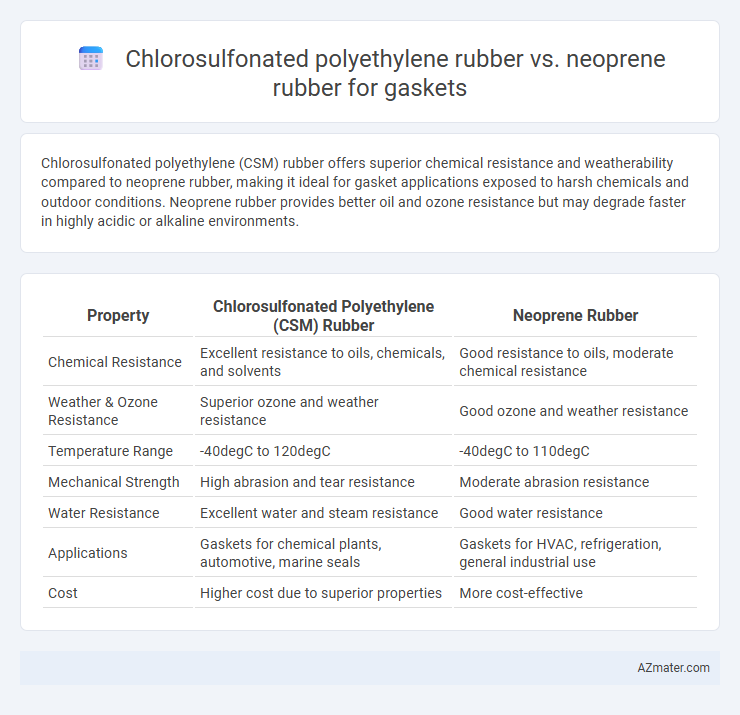Chlorosulfonated polyethylene (CSM) rubber offers superior chemical resistance and weatherability compared to neoprene rubber, making it ideal for gasket applications exposed to harsh chemicals and outdoor conditions. Neoprene rubber provides better oil and ozone resistance but may degrade faster in highly acidic or alkaline environments.
Table of Comparison
| Property | Chlorosulfonated Polyethylene (CSM) Rubber | Neoprene Rubber |
|---|---|---|
| Chemical Resistance | Excellent resistance to oils, chemicals, and solvents | Good resistance to oils, moderate chemical resistance |
| Weather & Ozone Resistance | Superior ozone and weather resistance | Good ozone and weather resistance |
| Temperature Range | -40degC to 120degC | -40degC to 110degC |
| Mechanical Strength | High abrasion and tear resistance | Moderate abrasion resistance |
| Water Resistance | Excellent water and steam resistance | Good water resistance |
| Applications | Gaskets for chemical plants, automotive, marine seals | Gaskets for HVAC, refrigeration, general industrial use |
| Cost | Higher cost due to superior properties | More cost-effective |
Introduction to Gasket Materials
Chlorosulfonated polyethylene (CSPE) rubber and neoprene rubber are widely used materials for gaskets due to their excellent chemical resistance and durability. CSPE offers superior resistance to weathering, ozone, and chemicals such as acids and alkalis, making it suitable for harsh industrial environments. Neoprene rubber provides balanced flexibility, moderate chemical resistance, and good compression set properties, often preferred for applications requiring resilience and water resistance.
Overview of Chlorosulfonated Polyethylene (CSM) Rubber
Chlorosulfonated polyethylene (CSM) rubber, known for its excellent chemical resistance, particularly against oils, solvents, and oxidizing agents, is widely used in gaskets requiring durability in harsh environments. Its superior weathering and ozone resistance, along with high tensile strength and flexibility, make CSM rubber a robust choice compared to neoprene rubber, which offers good general-purpose resistance but less chemical stability. CSM's low permeability and resistance to heat aging contribute to enhanced gasket longevity in industrial applications involving exposure to aggressive chemicals and extreme conditions.
Overview of Neoprene Rubber
Neoprene rubber, also known as polychloroprene, offers excellent chemical stability, weathering resistance, and moderate oil resistance, making it a versatile choice for gaskets in various industrial applications. It maintains flexibility over a wide temperature range and provides good compression set resistance, ensuring effective sealing performance. Compared to chlorosulfonated polyethylene rubber, neoprene exhibits superior resistance to ozone and UV exposure, enhancing gasket durability in outdoor and harsh environments.
Chemical Resistance Comparison
Chlorosulfonated polyethylene (CSPE) rubber offers superior resistance to acids, alkalis, and oxidizing chemicals compared to Neoprene rubber, making it ideal for gaskets exposed to harsh industrial environments. Neoprene exhibits good resistance to oils and solvents but is less effective against strong acids and oxidants than CSPE. For applications requiring long-term exposure to aggressive chemicals, CSPE gaskets provide enhanced durability and chemical stability.
Temperature Resistance and Stability
Chlorosulfonated polyethylene (CSPE) rubber offers excellent temperature resistance, maintaining stability in a range from -40degC to 130degC, making it suitable for gaskets exposed to harsh thermal environments. Neoprene rubber typically performs well between -30degC and 100degC, but its stability declines at higher temperatures, which may limit its application in high-heat sealing contexts. CSPE's superior resistance to heat aging and chemical exposure provides enhanced durability and consistent performance in gasket applications requiring long-term thermal stability.
Mechanical Properties and Durability
Chlorosulfonated polyethylene (CSM) rubber offers superior chemical resistance and enhanced weathering resistance compared to neoprene rubber, making it ideal for gaskets exposed to harsh environmental conditions. Neoprene rubber provides excellent flexibility and good mechanical strength, but it generally exhibits lower resistance to UV radiation and ozone degradation than CSM. The durability of CSM gaskets surpasses neoprene in prolonged outdoor applications due to its enhanced tensile strength and abrasion resistance, ensuring longer service life under mechanical stress.
Weathering, Ozone, and UV Resistance
Chlorosulfonated polyethylene (CSM) rubber exhibits superior weathering, ozone, and UV resistance compared to neoprene rubber, making it ideal for gaskets exposed to harsh environmental conditions. CSM maintains elasticity and physical properties over prolonged outdoor exposure, resisting cracking and degradation caused by ozone and ultraviolet radiation. Neoprene offers good overall resistance but tends to harden and lose flexibility faster than CSM when subjected to sunlight and ozone-rich environments.
Cost Analysis: CSM vs Neoprene for Gaskets
Chlorosulfonated polyethylene (CSM) rubber generally presents a higher initial cost than Neoprene rubber due to its enhanced chemical resistance and durability in harsh environments. Neoprene, being more widely produced and versatile, offers a more cost-effective solution for standard gasket applications without extreme chemical exposure. Long-term cost savings with CSM gaskets arise from reduced maintenance and replacement frequency in aggressive conditions, making it economically advantageous despite the upfront price difference.
Common Applications in Gasket Manufacturing
Chlorosulfonated polyethylene (CSPE) rubber is widely used in gasket manufacturing for applications requiring superior resistance to weathering, ozone, and chemical exposure, particularly in automotive and marine environments. Neoprene rubber gaskets are favored for their excellent oil, heat, and flame resistance, making them suitable for industrial machinery, refrigeration, and HVAC systems. Both materials provide durable sealing solutions, but CSPE excels in harsh outdoor conditions while Neoprene is more versatile for general-purpose gaskets.
Choosing the Right Rubber for Your Gasket Needs
Chlorosulfonated polyethylene (CSPE) rubber offers superior chemical resistance, UV stability, and weathering durability, making it ideal for outdoor and harsh industrial environments. Neoprene rubber provides excellent oil, ozone, and flame resistance, suitable for gaskets exposed to moderate chemicals and fluctuating temperatures. Selecting the right gasket rubber depends on the specific exposure conditions, with CSPE favored for aggressive chemicals and outdoor use, while neoprene excels in general-purpose sealing applications requiring moderate chemical and temperature resilience.

Infographic: Chlorosulfonated polyethylene rubber vs Neoprene rubber for Gasket
 azmater.com
azmater.com